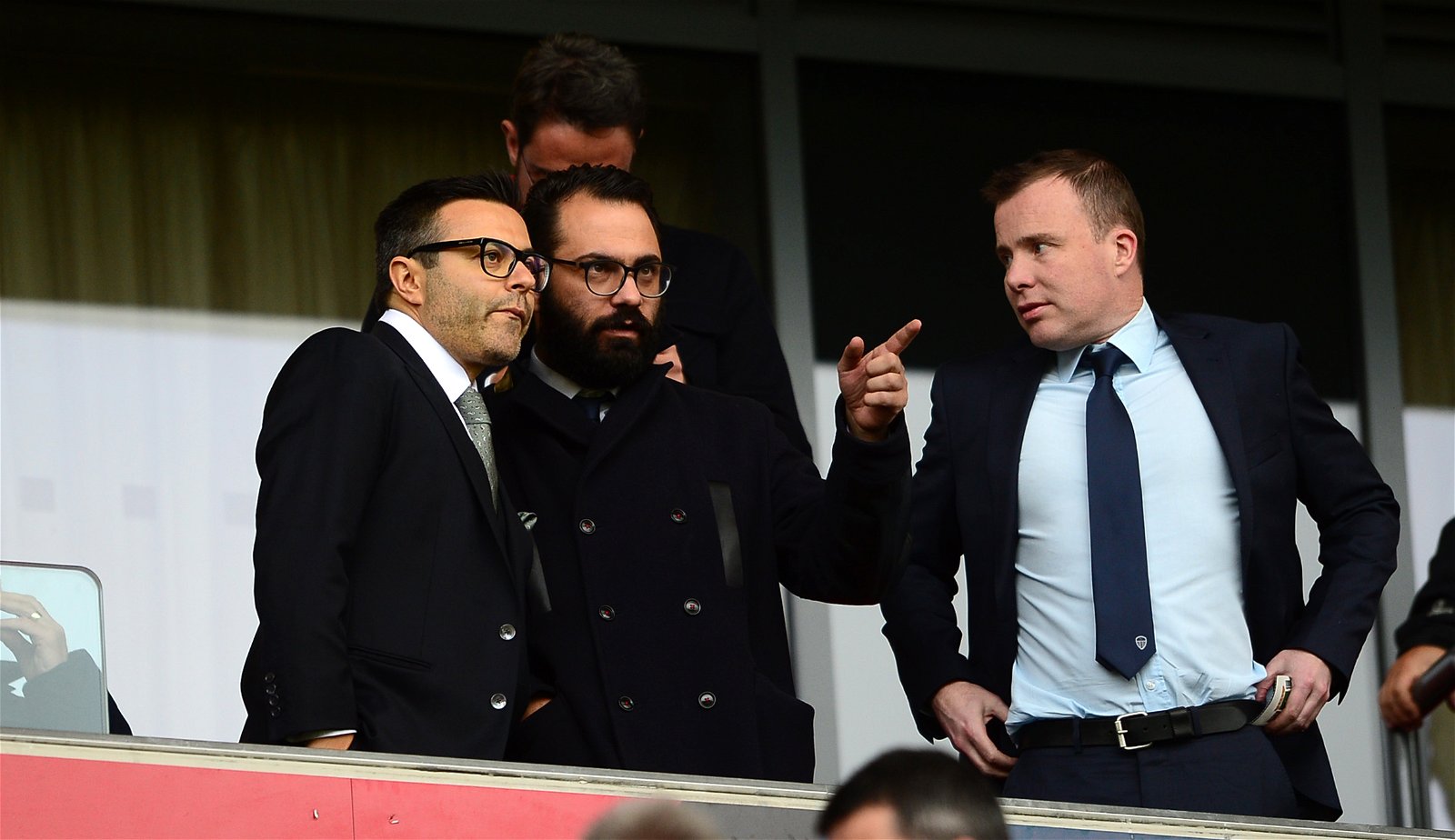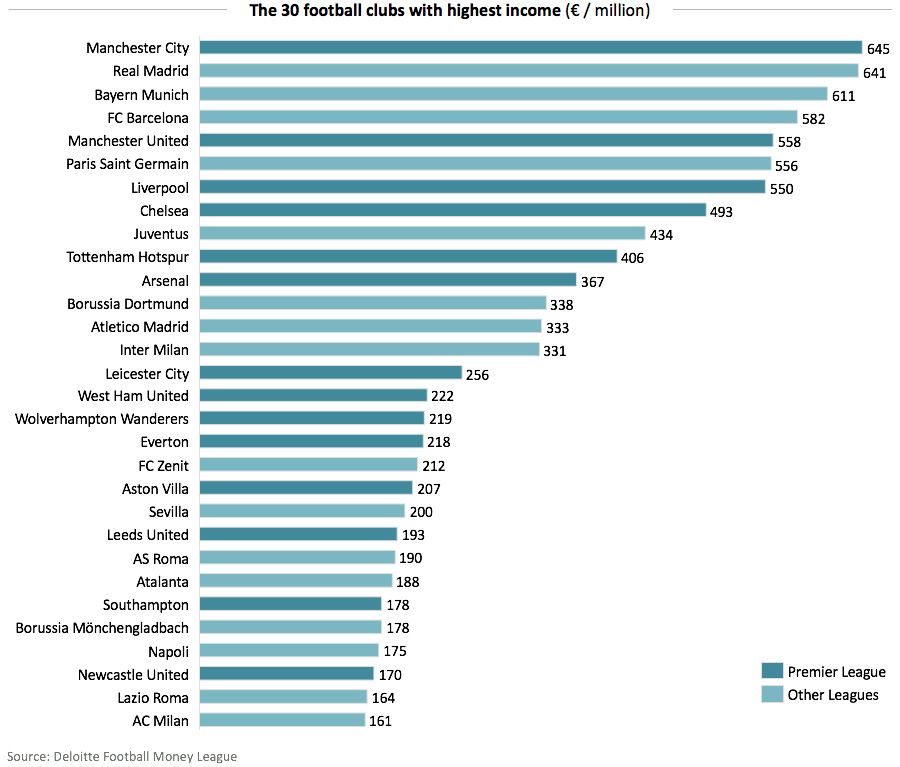
Last month we dove into Leeds United’s annual accounts for the 2020/21 season. The numbers painted a positive picture for Radrizzani and Leeds, but how does their financial situation compare to their rivals in the Premier League and further afield? I’m going to have an in-depth look and see the financial potential at Elland Road going forward, and how dependant that is on them staying in the Premier League.
Back amongst the elite in turnover
Leeds United’s revenue is amongst the highest in Europe as a result of their continued Premier League status. The Whites’ return to the Premier League in 2020/21 saw them claim a place in the top 25 of Deloitte’s Money League 2022. Leeds sit in 23rd position in the recently released table. Their £171 million turnover for the 2020/21 season more than tripled from the previous year, propelling them into Europe’s financial elite. Sandwiched between European heavyweights Sevilla and Roma, Leeds were less than 20 million euros off Zenit St Petersburg and a place in the top 20.
The fact that Leeds find themselves in such a lofty position after their first season back in the top flight is indicative of the financial power of the Premier League. In fact, English sides accounted for ten of the top 20 positions in the table and 14 of the top 30. This is perhaps no surprise, considering the enormous advantage the Premier League’s current broadcasting deal gives its clubs. The current deal with Sky, BT and Amazon runs until 2025 and is worth around £5.1 billion to Premier League clubs. This figure dwarfs the broadcasting deals of the rest of Europe’s top five leagues. La Liga currently hold the second most valuable broadcasting deal in Europe, worth just over £4.1 billion. Meanwhile, the Bundesliga’s current deal is thought to be just £3.7 billion while Serie A’s shorter contract is only worth £2.3 billion. Ligue 1 round out Europe’s top five leagues with a deal believed to be worth just a third of the one struck by Premier League clubs annually. The Premier League’s broadcasting dominance has given its clubs financial superiority in Europe, at least in terms of revenue.
For Leeds, this situation is a reminder of the importance of retaining their top-flight status if they are to remain in such a strong financial position. The monetary value of Premier League membership to Leeds is no secret. Their broadcasting income rose by over £124 million in the season following promotion, from just £8.7 million to a massive £132.8 million. In total, broadcasting income accounted for 78% of the club’s turnover in 2020/21, although this was slightly skewed by all but one Premier League home game being played behind closed doors. With the Whites hovering dangerously over the relegation trapdoor, these numbers reinforce the financial cost should Jesse Marsch’s men plummet into the Championship.
Competing commercially on the domestic stage
Within the Premier League itself, Leeds have fared well upon their return to the big stage. A club record turnover in 2020/21 was enough to record the 12th highest total revenue in the division after 16 years away. The Whites were £22 million behind West Ham who took the final place in the league’s top ten. Despite the enormous growth in Leeds’ revenue, they and the rest of the league remain in the shadow of the big six and their monstrous income. Arsenal, who rounded out the top six, recorded a turnover almost double that of Leeds, despite finishing just one place and two points ahead of them that year. Meanwhile, champions Manchester City’s £570 million revenue was over three times what Leeds raked in. While the big six remain out of reach for Leeds, they competed well with the rest of the league commercially. Leicester, Wolves, Everton, West Ham and Aston Villa were the only other teams who bettered their total revenue.

Leeds’ success was partially down to the genius of Marcelo Bielsa on the pitch. Their 9th placed finish brought them a greater share of the 25% of the broadcasting deal that is distributed based on league performance across the season. Unfortunately, the Whites’ on field performances this term will see their share of the Premier League television money decrease. However, their impressive turnover was also a result of the commercial success brought about by their size and popularity. The club have recognised the strategic and structural advantages of “Leeds United being the only club in the UK’s third biggest city.” This has helped them to post significantly high commercial and merchandising income over the last two years.
Promotion to the Premier League catalysed a 32.5% increase to an already respectable merchandising income of over £15 million. This saw the club recoup more than £20 million from merchandising in 2020/21, bringing their total commercial revenue to just under £36 million. Outside of the Premier League’s big six, only Everton and Leicester posted bigger commercial turnovers than Leeds. Commercial income accounted for 21% of Leeds’ total turnover last season. Only the big six and Everton were more reliant on their commercial success. Once again, the league’s big six dwarfed the commercial incomes of the rest of the division. Arsenal, sixth in the Premier League for commercial revenue, received £100 million more than the Whites from commercial channels. Manchester City led the Premier League in this category recouping £272 million, over seven times more than the Yorkshire side. While Leeds cannot compete with the gap created by the country’s financial elite, they have acquitted themselves well against the rest of the Premier League. Despite not playing top level football for 16 years, only Premier League perennials Everton and recent champions Leicester outperformed their commercial success. This demonstrates the financial potential of a club the size of Leeds, particularly if they are able to consolidate their Premier League position.

Bleeding money in the transfer market
In terms of expenditure, Leeds have gambled heavily since promotion when it comes to transfer fees. The Whites rank eighth in the Premier League for net spend this season after splurging £53 million on Dan James, Junior Firpo, Jack Harrison and Kristoffer Klaesson. This comes a year after spending £96 million on new players, such as Raphinha, Rodrigo, Helder Costa, Diego Lllorente, Robin Koch and Illan Meslier ahead of the 2020/21 season. Only Chelsea had a higher net spend than Leeds that summer. The Whites costly transfer business has been compounded by the fact they failed to receive a fee for a departing player in both seasons.
Big on fees, low on wages
On top of large transfer fees, wages increased by 38% to £108 million following promotion, thanks to a combination of new players and promotion bonuses for the existing squad. Despite the dramatic increase, Leeds still operate on one of the lowest wage budgets in the top-flight. Of Premier League clubs to have released their annual accounts for the 2020/21 season, only Sheffield United spent less on wages than Leeds at £57 million. The league’s top spenders, Manchester City, racked up a wage bill of £355 million, over three times that of Leeds. This demonstrates the financial might that Leeds are competing with while operating on a relatively small budget, despite their aggressive transfer policy. However, it also bodes well should Leeds slip back into the Championship. While relegation would undoubtedly mean players would have to depart, a smaller wage budget indicates that it would not be unsustainable to retain the majority of the squad. This contrasts with the situation at fellow strugglers Everton, who boast a wage bill £75 million a year larger than Leeds and would face financial catastrophe in the second tier.
Despite the increase, #LUFC £108m wage bill is the second lowest in 2020/21 Premier League to date, only above #SUFC. Even if we take the £118m wages (for annualised 12 months) this would still place them firmly in the bottom half of the table. pic.twitter.com/CFUlqOusKu
— Swiss Ramble (@SwissRamble) April 11, 2022
Going forwards: Bright future or relegation and contraction?
All in all, Leeds’ finances look healthy when compared to the rest of the league and Europe as a whole. This is shown by the fact only Wolves (£145 million) posted a larger profit than the Whites’ £25 million surplus in 2020/21. In fact, Leeds were one of just four Premier League clubs to make a profit that year, with Chelsea finding themselves £156 million in the red at the other end of the spectrum. Promotion to the Premier League has placed Leeds at the door of Europe’s elite in terms of revenue and turnover. Meanwhile, their size and success has allowed them to compete with more established Premier League clubs commercially. While Radrizzani has faced big losses in the transfer market, wages have remained relatively low. Therefore, while relegation would shatter the club’s revenue streams, they remain well placed to absorb the impact should the worst happen. Should Marsch secure safety, the future looks bright for Leeds off the pitch as well as on it.


















